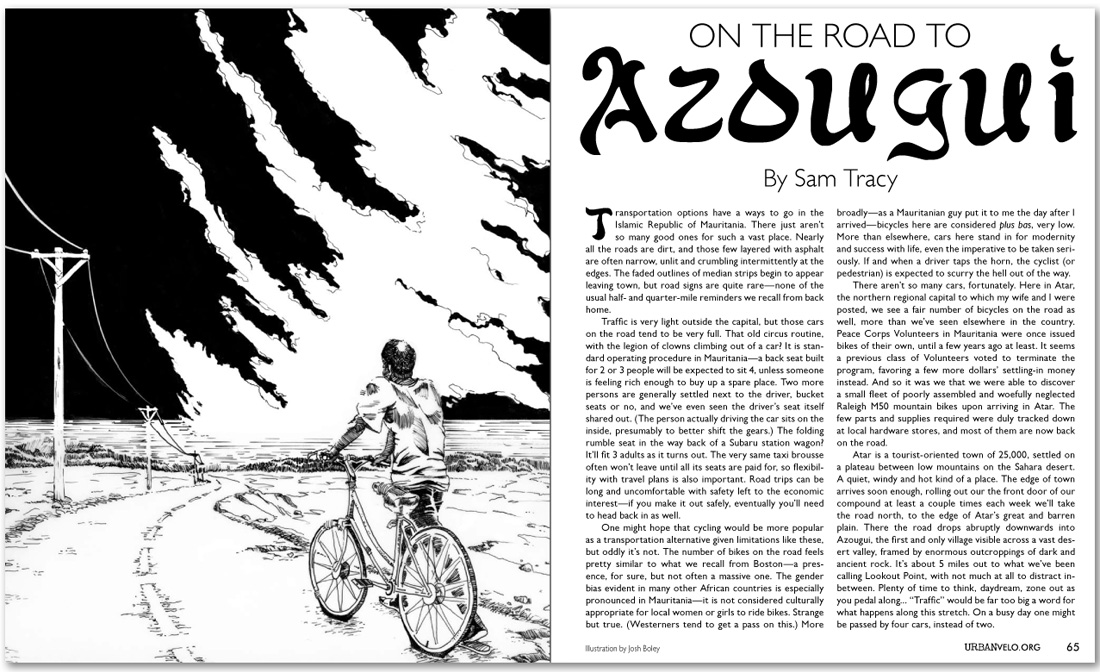

|
||||
On the Road to Azouguiby Sam Tracy Transportation options have a ways to go in the Islamic Republic of Mauritania. There just aren’t so many good ones for such a vast place. Nearly all the roads are dirt, and those few layered with asphalt are often narrow, unlit and crumbling intermittently at the edges. The faded outlines of median strips begin to appear leaving town, but road signs are quite rare—none of the usual half- and quarter-mile reminders we recall from back home. Traffic is very light outside the capital, but those cars on the road tend to be very full. That old circus routine, with the legion of clowns climbing out of a car? It is standard operating procedure in Mauritania—a back seat built for 2 or 3 people will be expected to sit 4, unless someone is feeling rich enough to buy up a spare place. Two more persons are generally settled next to the driver, bucket seats or no, and we’ve even seen the driver’s seat itself shared out. (The person actually driving the car sits on the inside, presumably to better shift the gears.) The folding rumble seat in the way back of a Subaru station wagon? It’ll fit 3 adults as it turns out. The very same taxi brousse often won’t leave until all its seats are paid for, so flexibility with travel plans is also important. Road trips can be long and uncomfortable with safety left to the economic interest—if you make it out safely, eventually you’ll need to head back in as well. One might hope that cycling would be more popular as a transportation alternative given limitations like these, but oddly it’s not. The number of bikes on the road feels pretty similar to what we recall from Boston—a presence, for sure, but not often a massive one. The gender bias evident in many other African countries is especially pronounced in Mauritania—it is not considered culturally appropriate for local women or girls to ride bikes. Strange but true. (Westerners tend to get a pass on this.) More broadly—as a Mauritanian guy put it to me the day after I arrived—bicycles here are considered plus bas, very low. More than elsewhere, cars here stand in for modernity and success with life, even the imperative to be taken seriously. If and when a driver taps the horn, the cyclist (or pedestrian) is expected to scurry the hell out of the way. There aren’t so many cars, fortunately. Here in Atar, the northern regional capital to which my wife and I were posted, we see a fair number of bicycles on the road as well, more than we’ve seen elsewhere in the country. Peace Corps Volunteers in Mauritania were once issued bikes of their own, until a few years ago at least. It seems a previous class of Volunteers voted to terminate the program, favoring a few more dollars’ settling-in money instead. And so it was we that we were able to discover a small fleet of poorly assembled and woefully neglected Raleigh M50 mountain bikes upon arriving in Atar. The few parts and supplies required were duly tracked down at local hardware stores, and most of them are now back on the road. Atar is a tourist-oriented town of 25,000, settled on a plateau between low mountains on the Sahara desert. A quiet, windy and hot kind of a place. The edge of town arrives soon enough, rolling out our the front door of our compound at least a couple times each week we’ll take the road north, to the edge of Atar’s great and barren plain. There the road drops abruptly downwards into Azougui, the first and only village visible across a vast desert valley, framed by enormous outcroppings of dark and ancient rock. It’s about 5 miles out to what we’ve been calling Lookout Point, with not much at all to distract in-between. Plenty of time to think, daydream, zone out as you pedal along... “Traffic” would be far too big a word for what happens along this stretch. On a busy day one might be passed by four cars, instead of two. |
|
|
|